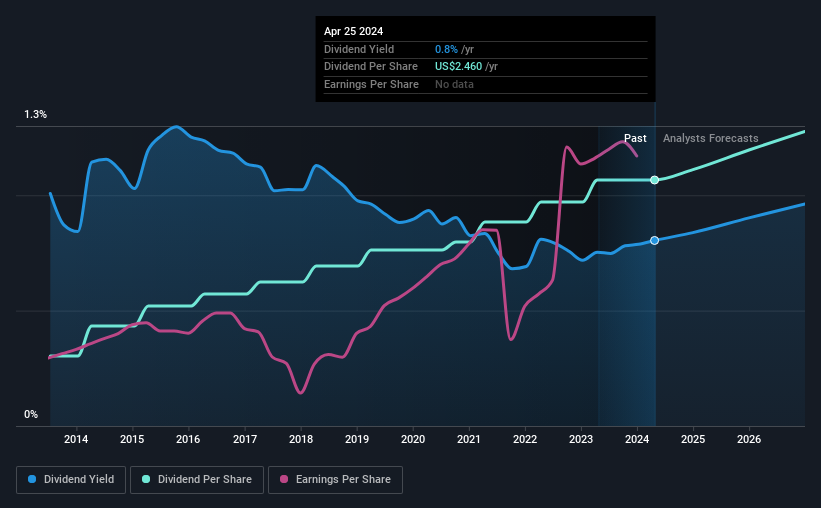- United States
- /
- Insurance
- /
- NYSE:AON
Why You Might Be Interested In Aon plc (NYSE:AON) For Its Upcoming Dividend
Regular readers will know that we love our dividends at Simply Wall St, which is why it's exciting to see Aon plc (NYSE:AON) is about to trade ex-dividend in the next 3 days. The ex-dividend date is one business day before the record date, which is the cut-off date for shareholders to be present on the company's books to be eligible for a dividend payment. The ex-dividend date is important as the process of settlement involves two full business days. So if you miss that date, you would not show up on the company's books on the record date. Therefore, if you purchase Aon's shares on or after the 30th of April, you won't be eligible to receive the dividend, when it is paid on the 15th of May.
The company's next dividend payment will be US$0.675 per share. Last year, in total, the company distributed US$2.46 to shareholders. Looking at the last 12 months of distributions, Aon has a trailing yield of approximately 0.8% on its current stock price of US$306.00. Dividends are a major contributor to investment returns for long term holders, but only if the dividend continues to be paid. So we need to investigate whether Aon can afford its dividend, and if the dividend could grow.
Check out our latest analysis for Aon
Dividends are typically paid out of company income, so if a company pays out more than it earned, its dividend is usually at a higher risk of being cut. Aon is paying out just 19% of its profit after tax, which is comfortably low and leaves plenty of breathing room in the case of adverse events.
Companies that pay out less in dividends than they earn in profits generally have more sustainable dividends. The lower the payout ratio, the more wiggle room the business has before it could be forced to cut the dividend.
Click here to see the company's payout ratio, plus analyst estimates of its future dividends.

Have Earnings And Dividends Been Growing?
Companies with consistently growing earnings per share generally make the best dividend stocks, as they usually find it easier to grow dividends per share. If business enters a downturn and the dividend is cut, the company could see its value fall precipitously. It's encouraging to see Aon has grown its earnings rapidly, up 24% a year for the past five years.
Another key way to measure a company's dividend prospects is by measuring its historical rate of dividend growth. Aon has delivered 13% dividend growth per year on average over the past 10 years. It's exciting to see that both earnings and dividends per share have grown rapidly over the past few years.
Final Takeaway
Has Aon got what it takes to maintain its dividend payments? Companies like Aon that are growing rapidly and paying out a low fraction of earnings, are usually reinvesting heavily in their business. This is one of the most attractive investment combinations under this analysis, as it can create substantial value for investors over the long run. Overall, Aon looks like a promising dividend stock in this analysis, and we think it would be worth investigating further.
In light of that, while Aon has an appealing dividend, it's worth knowing the risks involved with this stock. For example, we've found 3 warning signs for Aon (1 is significant!) that deserve your attention before investing in the shares.
A common investing mistake is buying the first interesting stock you see. Here you can find a full list of high-yield dividend stocks.
New: Manage All Your Stock Portfolios in One Place
We've created the ultimate portfolio companion for stock investors, and it's free.
• Connect an unlimited number of Portfolios and see your total in one currency
• Be alerted to new Warning Signs or Risks via email or mobile
• Track the Fair Value of your stocks
Have feedback on this article? Concerned about the content? Get in touch with us directly. Alternatively, email editorial-team (at) simplywallst.com.
This article by Simply Wall St is general in nature. We provide commentary based on historical data and analyst forecasts only using an unbiased methodology and our articles are not intended to be financial advice. It does not constitute a recommendation to buy or sell any stock, and does not take account of your objectives, or your financial situation. We aim to bring you long-term focused analysis driven by fundamental data. Note that our analysis may not factor in the latest price-sensitive company announcements or qualitative material. Simply Wall St has no position in any stocks mentioned.
About NYSE:AON
Aon
A professional services firm, provides a range of risk and human capital solutions worldwide.
Adequate balance sheet average dividend payer.
Similar Companies
Market Insights
Community Narratives



